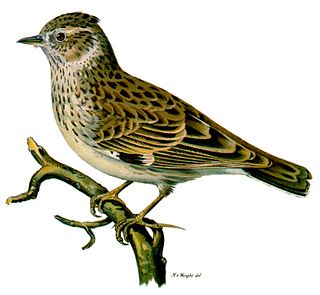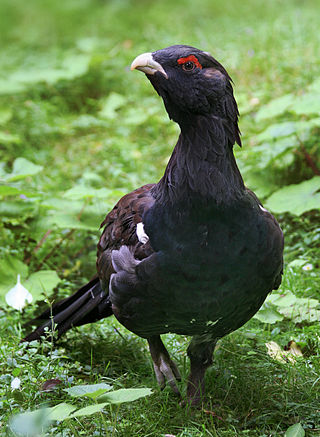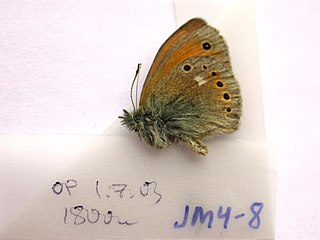
The Miocene is the first geological epoch of the Neogene Period and extends from about 23.03 to 5.333 million years ago (Ma). The Miocene was named by Scottish geologist Charles Lyell; the name comes from the Greek words μείων and καινός and means "less recent" because it has 18% fewer modern marine invertebrates than the Pliocene has. The Miocene followed the Oligocene and preceded the Pliocene.

Falcons are birds of prey in the genus Falco, which includes about 40 species. Some small species of falcons with long, narrow wings are called hobbies, and some that hover while hunting are called kestrels. Falcons are widely distributed on all continents of the world except Antarctica, though closely related raptors did occur there in the Eocene.

A pika is a small, mountain-dwelling mammal native to Asia and North America. With short limbs, a very round body, an even coat of fur, and no external tail, they resemble their close relative the rabbit, but with short, rounded ears. The large-eared pika of the Himalayas and nearby mountains lives at elevations of more than 6,000 m (20,000 ft).

The Accipitridae is one of the four families within the order Accipitriformes, and is a family of small to large birds of prey with strongly hooked bills and variable morphology based on diet. They feed on a range of prey items from insects to medium-sized mammals, with a number feeding on carrion and a few feeding on fruit. The Accipitridae have a cosmopolitan distribution, being found on all the world's continents and a number of oceanic island groups. Some species are migratory. The family contains 256 species which are divided into 12 subfamilies and 75 genera.

The Anatidae are the biological family of water birds that includes ducks, geese, and swans. The family has a cosmopolitan distribution, occurring on all the world's continents except Antarctica. These birds are adapted for swimming, floating on the water surface, and, in some cases, diving in at least shallow water. The family contains around 174 species in 43 genera.

Gannets are seabirds comprising the genus Morus in the family Sulidae, closely related to boobies. They are known as 'solan' or 'solan goose' in Scotland. A common misconception is that the Scottish name is 'guga' but this is the Gaelic name referring to the chicks only.

Deinotherium is an extinct genus of large, elephant-like proboscideans that lived from about the middle-Miocene until the early Pleistocene. Although its appearance is reminiscent of modern elephants, Deinotherium possessed a notably more flexible neck, with limbs adapted to a more cursorial lifestyle, as well as tusks which grew down and curved back from the mandible, as opposed to the forward-growing maxillary tusks of extant elephants. Deinotherium was a widespread genus, ranging from East Africa, north to Southern Europe, and east to the Indian subcontinent. They were primarily browsing animals, with a diet largely consisting of leaves. The genus most likely went extinct due to environmental changes, such as forested areas gradually being replaced by open grasslands, during the latter half of the Neogene. Deinotherium thrived the longest in Africa, where they survived until the end of the Early Pleistocene, around 1 million years ago.

Eutamias is a genus of chipmunks within the tribe Marmotini of the squirrel family. It includes a single living species, the Siberian chipmunk. The genus is often treated as a subgenus of Tamias, which is now restricted to the eastern chipmunk of North America. Neotamias, which now includes the western North American chipmunks, has also been included in Eutamias.

Lullula is the genus of woodlarks, songbirds in the family Alaudidae. There is only one remaining extant species, the woodlark which is found in Europe, the mountains of northern Africa, the Middle East and western Asia. The remainder are known only from the fossil record.

Circaetus, the snake eagles, is a genus of medium-sized eagles in the bird of prey family Accipitridae. They are mainly resident African species, but the migratory short-toed snake eagle breeds from the Mediterranean basin into Russia, the Middle East and India, and winters in sub-Saharan Africa and east to Indonesia.

The black-chested snake eagle or black-breasted snake eagle is a large African bird of prey of the family Accipitridae. It resembles other snake eagles and was formerly considered conspecific with the short-toed and Beaudouin's snake eagles, to which it is closely related.

Tetrao is a genus of birds in the grouse subfamily known as capercaillies. They are some of the largest living grouse. Feathers from the bird were used to create the characteristic hat of the bersaglieri, an Italian ace infantry formation.
Paleontology or palaeontology is the study of prehistoric life forms on Earth through the examination of plant and animal fossils. This includes the study of body fossils, tracks (ichnites), burrows, cast-off parts, fossilised feces (coprolites), palynomorphs and chemical residues. Because humans have encountered fossils for millennia, paleontology has a long history both before and after becoming formalized as a science. This article records significant discoveries and events related to paleontology that occurred or were published in the year 1998.

Coenonympha rhodopensis is a butterfly of the family Nymphalidae. It is found in Italy, Romania, Bulgaria, Albania, northern Greece, Serbia and Montenegro.

Byala reka is a river in the Rhodope Mountains in Southern Bulgaria, the longest tributary of Luda reka.

Dinocrocuta is an extinct genus of large percrocutid. It lived in Eurasia and Africa during the late Miocene epoch. It had very strong jaws that were able to crush bones. It considerably exceeded the size of living hyenas.

Adcrocuta is an extinct genus of large hyena that lived in Africa and Eurasia during the late Miocene epoch.

Brachythele is a genus of spiders in the family Nemesiidae. It was first described in 1871 by Ausserer. As of 2022, it contains 10 species from eastern Europe.

Titanochelon is an extinct genus of giant tortoises known from the Early Miocene to the beginning of the Pleistocene in Europe, extending from the Iberian Peninsula to Anatolia. Some members of the genus were larger than extant giant tortoises, with a shell length of up to 2 m.
Circaetus haemusensis is an extinct species of Circaetus that lived in northwestern Bulgaria during the Early Pleistocene.

















